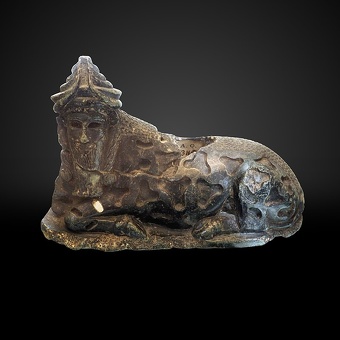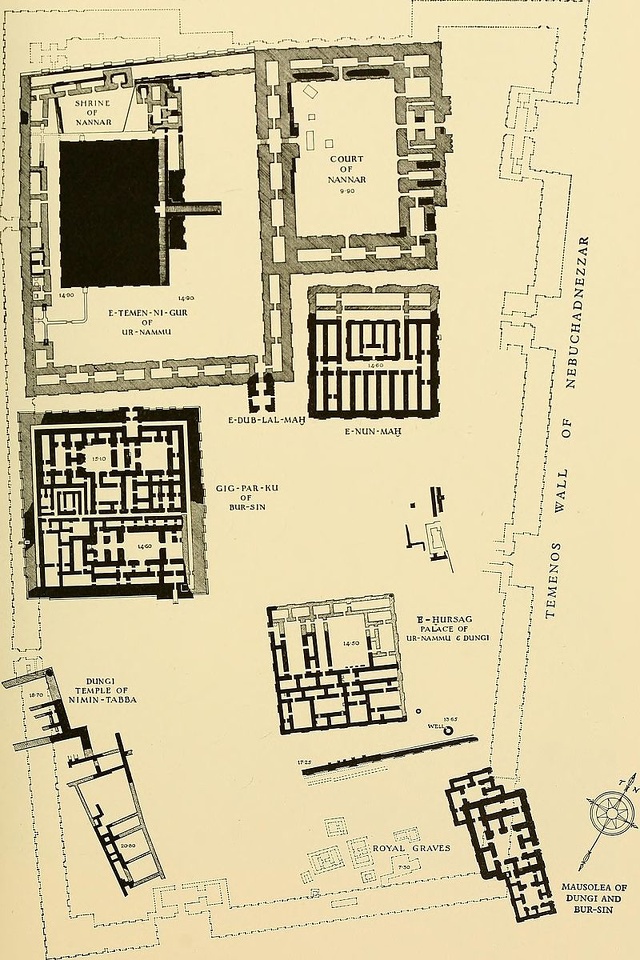Home | Category: Sumerians and Akkadians
UR
Ur (eight kilometers, five miles from Nasiriyah, Iraq, near the town of Muqaiyir) ) was a great Mesopotamian city and the traditional birthplace of Abraham, the patriarch of Christianity, Judaism and Islam. Founded in the 5th millennium B.C., it covers around 120 acres and was originally on the Euphrates River, which now lies several miles to the north.
Around 2000 B.C.Ur was the capital of a Mesopotamian empire. It ziggurat (a pyramid-like brick tower) housed a shrine to the moon god Nanna on its summit. A three-tier mass of mud bricks, the structure has been restored several times during its long history.
The Bible refers to “Ur of the Chaldees” as the place where Abraham lived before heading off to Canaan. Archaeologists have said their isn’t much evidence that the Mesopotamian Ur was the one mentioned in the Bible. A house said to belong to Abraham was built by Saddam Hussein after Pope John Paul II said he in the 1990s he interested in visiting it.
Ur’s Sumerian rulers accrued great wealth in the mid-third millennium B.C. thanks to robust trading relationships with other cities. Although now situated on a flat and dry plain, Ur once was a bustling port on the Euphrates River laced with canals and filled with merchant ships, warehouses, and weaving factories. A massive stepped pyramid, or ziggurat, rose above the city and still dominates the landscape today.” Ur today is a dusty and depressing. The only hint that it was once a great is the ziggurat. Some of the royal tombs are well preserved. The largest house, dating between 2000 and 1596 B.C., is sometimes described as Abraham’s house although there is evidence to back up this claim.
RELATED ARTICLES:
SUMERIANS: SUMER, HISTORY, ORIGINS, IRRIGATION africame.factsanddetails.com ;
SUMERIAN RULERS, GOVERNMENT, WARFARE africame.factsanddetails.com ;
SUMERIAN LIFE, CULTURE AND LANGUAGE africame.factsanddetails.com ;
SUMERIAN RELIGION: CITY-STATE GODS, TEMPLES africame.factsanddetails.com ;
SUMERIAN ART AND TREASURES FROM THE TOMBS OF UR africame.factsanddetails.com ;
SUMERIAN CITY STATES AND CITIES: URUK, LAGASH AND GIRSU africame.factsanddetails.com ;
NIPPUR: THE RELIGIOUS CENTER OF MESOPOTAMIA africame.factsanddetails.com ;
DECLINE OF THE SUMERIANS AND THEIR FALL TO THE AKKADIANS AND ELAMITES africame.factsanddetails.com ;
AKKADIANS: EMPIRE, SARGON. LANGUAGE, CULTURE africame.factsanddetails.com
Websites on Mesopotamia: Internet Ancient History Sourcebook: Mesopotamia sourcebooks.fordham.edu ; Institute for the Study of Ancient Cultures, University of Chicago isac.uchicago.edu ; University of Chicago Near Eastern Languages and Civilizations nelc.uchicago.edu ; University of Pennsylvania Near Eastern Languages & Civilizations (NELC) nelc.sas.upenn.edu; Penn Museum Near East Section penn.museum; Ancient History Encyclopedia ancient.eu.com/Mesopotamia ; British Museum britishmuseum.org ; Louvre louvre.fr/en/explore ; Metropolitan Museum of Art metmuseum.org/toah ; Ancient Near Eastern Art Metropolitan Museum of Art metmuseum.org; Iraq Museum theiraqmuseum ABZU etana.org/abzubib; Archaeology Websites Archaeology News Report archaeologynewsreport.blogspot.com ; Anthropology.net anthropology.net : archaeologica.org archaeologica.org ; Archaeology in Europe archeurope.com ; Archaeology magazine archaeology.org ; HeritageDaily heritagedaily.com; Live Science livescience.com/
RECOMMENDED BOOKS:
“Ur: The City of the Moon God” by Harriet Crawford (2015) Amazon.com;
“Ur: A Captivating Guide to One of the Most Important Sumerian City-States” (2018) Amazon.com;
“Treasures from the Royal Tombs of Ur” by Richard L. Zettler and Lee Horne (1998) Amazon.com;
“On the Third Dynasty of Ur: Studies in Honor of Marcel Sigrist” (2008) Amazon.com;
“Excavations at Ur” by Sir Leonard Woolley Amazon.com;
“Abraham: One Nomad's Amazing Journey of Faith” by Charles R. Swindoll, Bob Souer, et al. Amazon.com ;
“Abraham: A Journey in the Heart of Three Faiths” by Bruce Feiler (William Morrow, 2002)
Amazon.com ;
“Abraham and Sarah: History's Most Fascinating Story of Faith and Love” by J. SerVaas Williams Amazon.com
“Uruk: The First City” (BibleWorld) by Mario Liverani , Zainab Bahrani, et al. (2006) Amazon.com;
“Uruk: First City of the Ancient World”
by Nicola Crusemann, Margarete van Ess, et al. (2019) Amazon.com;
“For the Gods of Girsu: City-State Formation in Ancient Sumer” by Sébastien Rey (2016) Amazon.com;
“Nippur V: The Area WF Sounding: The Early Dynastic to Akkadian Transition (Oriental Institute Publications) by Augusta McMahon , McGuire Gibson, et al. (2006) Amazon.com;
“Nippur IV: The Early Neo-Babylonian Governor's Archive from Nippur (Oriental Institute Publications) by Steven W. Cole (1996) Amazon.com;
“The Sumerians: Their History, Culture, and Character” by Samuel Noah Kramer (1971) Amazon.com;
“The Sumerians: A History from Beginning to End” by Hourly History (2023) Amazon.com;
“The Sumerians” by Leonard Woolley (1927) Amazon.com;
“History Begins at Sumer” by Samuel Noah Kramer (1956, 1988) Amazon.com;
“The Sumerian World” by Harriet Crawford (2013) Amazon.com;
“The Sumerian Civilization” (2022) Amazon.com;
History of Ur
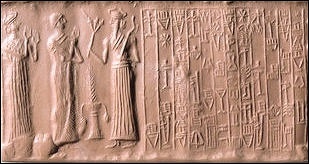
cylinder seal
Andrew Lawler wrote in National Geographic: “Ur emerged as a settlement more than 6,000 years ago and grew to prominence in the Early Bronze Age that began about a thousand years later. Some of the earliest known writing—called cuneiform—has been uncovered at Ur, including seals that mention the city. But the real heyday came around 2000 B.C., when Ur dominated southern Mesopotamia after the fall of the Akkadian Empire. The sprawling city was home to more than 60,000 people, and included quarters for foreigners as well as large factories producing wool clothes and carpets exported abroad. Traders from India and the Persian Gulf crowded the busy wharves, and caravans arrived regularly from what is now northern Iraq and Turkey. [Source :Andrew Lawler, National Geographic, March 11, 2016 -]
“This period saw the creation of the oldest known law code, the Code of Ur-Nammu, as well as one of the world’s most bureaucratic states. Fortunately for scholars today, its rulers were obsessed with recording the most minor of transactions on clay tablets, usually with a stylus fashioned from a reed. The tapering end of the bit of ebony, Stone said, hints that it was the stylus of a high-ranking scribe. -
Ur was unearthed in the 1920s and 30s by a team led by the British archaeologist Leonard Woolley, who found a great temple complex, royal tombs, and the remains of houses on city streets. In the tombs were treasures — including scores of stunning objects made with gold, silver and precious stones — that rivaled treasures found at famous burial sites in ancient Egypt. Most of the objects were taken to the British Museum. Bombing raids during the first Persian Gulf War left four craters in the temple precinct and 400 holes on the ziggurat.
Sir Leonard Woolley uncovered a lyre in one of Ur’s royal graves. Dating to about 2600 B.C., it musical instrument contains a bull with a beard of lapis lazuli—a stone brought from Afghanistan—that may represent the sun god. A small clay mask unearthed in December represents Humbaba, a fearsome deity believed to protect the cedar forests of distant Lebanon. Humbaba figures in the ancient Sumerian epic of Gilgamesh that was popular during Ur’s heyday around 2000 B.C. [Source:Andrew Lawler, National Geographic, March 11, 2016 -]
Life and People of Ur
The Penn Museum has a 6,500-year-old skeleton found in Ur between 1922 and 1934 by Sir Leonard Woolley. Penn curator Janet Monge told Archaeology magazine: the remains belonged to a muscular male in his 50s who stood about five feet nine inches tall. He had been buried with his legs extended, his arms lying at his sides, and his hands resting on his abdomen. Woolley recorded that the man was found in one of the earliest levels of Ur, in a layer of silt deposited by a great flood, leading some of the researchers to nickname the remains “Noah.” [Source: Jason Urbanus, Archaeology magazine, November-December 2014]
Ur was a busy port on the Euphrates very close to the Persian Gulf and a bustling metropolis with shops, narrow streets full of cattle carts and donkey caravan and craftsmen who made everything from leather goods to precious ornaments. At around 2100 B.C., when it was at its height, it was home to maybe 12,000 people. The Euphrates brought rich sediment that settled in a flood plain that was used to raise enough crops to support a large number of people. In the countryside around the city were groves of date palms and irrigated fields that produced barely, lentils, onions and garlic. Goats and sheep supplied ghee and wool.

Tower of Babel
Ur contained one of the largest ziggurats and had two ports that welcomed ships from as far as India. Roads linked it to present-day Iran, Turkey, Afghanistan, Syria, Egypt, and Israel. Ur’s city walls were the world's thickest. Over 88 feet thick and made of mud brick, they were destroyed by Elamites in 2006 B.C. Triangular arches mark what are said to be royal tommbs.
Ur in the Bible
Ur is mentioned in the Bible four times — Gen 11:28, Gen 11:31, Gen 15:7 and Neh 9:7.— most prominently as the hometown of Abraham. God told Abraham to leave Ur and to go to the land of Canaan (Israel). Ur is mentioned specifically in the Bible as "Ur of the Chaldeans," and each time in reference to Abraham or to a member of his family. The Chaldeans were a Semitic-speaking people that lived in Mesopotamia between the late 10th or early 9th and mid-6th centuries B.C.. They originated from outside Mesopotamia and were ultimately absorbed and assimilated into Babylonia. Chaldea — located in the marshy land of the far southeastern corner of Mesopotamia — briefly existed as a nation and ruled Babylon. [Source: aboutbibleprophecy.com]
The first mention of Ur in the Bible is in Genesis 11:28, where we learn that Abraham's brother, Haran, had died in Ur, which was also Haran's birthplace. Genesis 11:28 reads: “While his father Terah was still alive, Haran died in Ur of the Chaldeans, in the land of his birth.” The King James Versionof Genesis 11:31 reads: “And Terah took Abram his son, and Lot the son of Haran his son's son, and Sarai his daughter in law, his son Abram's wife; and they went forth with them from Ur of the Chaldees, to go into the land of Canaan; and they came unto Haran, and dwelt there.” [Source: biblegateway.com]
Genesis 15:5-10 reads: 5 He [God] took him [Abraham] outside and said, “Look up at the sky and count the stars—if indeed you can count them.” Then he said to him, “So shall your offspring be.”6 Abram believed the Lord, and he credited it to him as righteousness.7 He also said to him, “I am the Lord, who brought you out of Ur of the Chaldeans to give you this land to take possession of it.” 8 But Abram said, “Sovereign Lord, how can I know that I will gain possession of it?” 9 So the Lord said to him, “Bring me a heifer, a goat and a ram, each three years old, along with a dove and a young pigeon.” 10 Abram brought all these to him, cut them in two and arranged the halves opposite each other; the birds, however, he did not cut in half. 11 Then birds of prey came down on the carcasses, but Abram drove them away.
Nehemiah 9:7-8 reads: “7 “You are the Lord God, who chose Abram and brought him out of Ur of the Chaldeans and named him Abraham. 8 You found his heart faithful to you, and you made a covenant with him to give to his descendants the land of the Canaanites, Hittites, Amorites, Perizzites, Jebusites and Girgashites. You have kept your promise because you are righteous.”

Ziggurat of Ur
References to Abraham of Ur in Mesopotamian Tablets
Abraham hired an ox, Abraham leased a farm, Abraham paid part of his rent, how Abraham — Abraham of Ur of Chaldees — might have moved to Canaan are all texts derived from Mesopotamian cuneiform tablets. The Abraham referred to here is probably not of the Biblical Abraham but the texts on the tablets offers some insight into life during Abraham’s time. The Biblical Abraham had a different father and worshipped only one god. [Source: Fertile Crescent Travel, George Barton, “Archaeology and the Bible” 7th edition, American Sunday-School Union. p. 344-345]
Abraham Leased a Farm
To the patrician speak,
Saying, Gimil-Marduk (wishes that)
Shamash and Marduk may give thee health!
Mayest thou have peace, mayest thou have health!
May the god who protects thee thy head in luck
Hold!
(To enquire) concerning thy health I am sending.
May thy welfare before Shamash and Marduk
be eternal!
Concerning the 400 shars of land, the field of Sin-idinam,
Which to Abamrama
To lease, thou hast sent;
The land-steward the scribe
Appeared and
On behalf of Sin-idinam
I took that up.
The 400 shars of land to Abamrama
as thou hast directed
I have leased.
Concerning thy dispatches I shall not be negligent.
Abraham Paid His Rent
1 Shekel of silver
of the rent of his field,
for the year Ammizadugga, the king,
a lordly, splendid statu (set up),
brought
Abamrama,
received
Sin-idinam
and Iddatum
Month Siman, 28th day,
The year Ammizadugga, the king,
a lordly, splendid statu (set up)
[Note: This was Amizadugga's 13th year. Abraham is reported as paying part of his rent two years after he hired an ox]

Abraham and the Sacrifice of Isaac by Caravaggio
Abraham of Ur Buys an Oxen and Travels to Palestine
Abraham Hired an Ox:
One ox broken to the yoke,
An ox from Ibri-sin, son of Sin-imgurani,
From Ibni-sin
through the agency of Kishti-Nabium,
son of Eteru,
Abarama, son of Awel-Ishtar,
for one month has hired.
For one month
one shekel of silver
he will pay.
Of it 1/2 shekel of silver
from the hand of
Abarama
Kisti-Nabium
has received.
In the presence of Idin-Urash, son of Idin-Labibaal,
In the presence of Awele, son of Urri-bani,
in the presence of Beliyatum, scribe.
Month of the mission of Ishtar (i.e., Ammizadugga's 11th year).
The year of Ammizadugga, the king (built)
The wall of Ammizadugga, (i.e., Ammizadugga's 11th year).
[Source: Tablet of Kisti-Nabium, copy made for Kishti-Nabium, the agent, 1965 B.C., Ammizadugga was the tenth king of that first dynasty of Babylon, of which Hammurabi was the sixth]
Travel between Babylonia and Palestine
A wagon
from Mannum-balum-Shamash,
son of Shelibia,
Khabilkinum,
son of Appani[bi],
on a lease
for 1 year
has hired.
As a yearly rental
2/3 of a shekel of silver
he will pay.
As the first of the rent
1/6 of a shekel of silver
he has received.
Unto the land of Kittim
he shall not drive it.
In the presence of Ibku-Adad,
Son of Abiatum;
in the presence of Ilukasha,
son of Arad-ilishu;
in the presence of ilishu....
Month Ululu, day 25,
the year the king Erech from the flood
of the river as a frienc protected.
[Notes: This tablet is dated to the time of the migration of Abraham. Kittim is used in Jeremiah 2:10 and Ezekiel 27:6 of the coast lands of the Mediterranean. The contract protects the owner's wagon from being driven the long, scenic route along the coast. This was like a mileage limit on renting a U-Haul for a time period.]
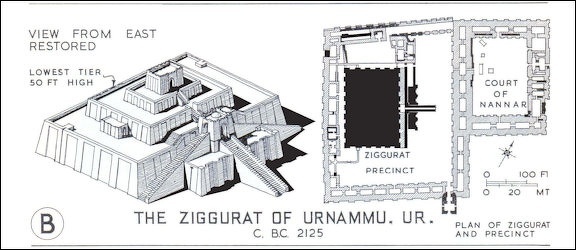
Ur, Like the Soviet Union?
Andrew Lawler wrote in National Geographic: “Archaeologists in the past assumed that Ur in its heyday was like the former Soviet Union in another way: A small privileged elite controlled a large population of workers, often assigned to grim work units to manufacture clothes, pots, and other consumer goods. Stone is challenging that theory. [Source: Andrew Lawler, National Geographic, March 11, 2016 -]
“This was the first planned economy,” said Dominique Charpin, a specialist in cuneiform at the College de France, during a break from examining recently unearthed tablets. “It was like the Soviet Union.” Most of the 28 tablets found during the excavation, he adds, deal with sales and rations of grain, wool, and bronze, as well as slaves and land registry. The sizes of the tablets vary, but all are crammed with tiny symbols that require a lighted magnifier to decipher. -
““There has been this assumption of inequality,” she said. “But more recent research points to social mobility in city-states like Ur. People could move up the economic ladder—that’s why they want to live in the city in the first place.”“ -
Ziggurat of Ur
The Ur’s ziggurat is a pyramid-like brick tower built in 2100 B.C. as a tribute to Sin, the moon god. It originally rose 65 feet from a base measuring 135 by 200 feet and had three platforms, each a different color, and a silver shrine at the top. About a third of it remains. Reaching a height of about 50 feet, it looks sort of like a castle wall filled in with dirt and ascended by a staircase. Some regard best preserved structure similar to the Tower of Babel.
According to the Metropolitan Museum of Art: “At the end of the fourth millennium B.C., enormous mud-brick platforms had been built at a number of sites in Mesopotamia. It is presumed that they originally supported important buildings, especially temples. By the mid-third millennium B.C., some temples were being built on huge stepped platforms. These are called ziggurats in cuneiformtexts. [Source: Department of Ancient Near Eastern Art. "Ur: The Ziggurat", Heilbrunn Timeline of Art History, New York: The Metropolitan Museum of Art, October 2002, \^/]
“While the actual significance of these structures is unknown, Mesopotamian gods were often linked with the eastern mountains, and ziggurats may have represented their lofty homes. Around 2100 B.C., southern Mesopotamian cities came under the control of Ur-Nammu, ruler of the city of Ur. In the tradition of earlier kings, Ur-Nammu built many temples, including ziggurats at Ur, Eridu, Uruk, and Nippur. Ziggurats continued to be built throughout Mesopotamia until Persian times (ca. 500 B.C.), when new religious ideas emerged. \^/
“Gradually the ziggurats decayed and the bricks were robbed for other buildings. However, their tradition survived through such stories as the Tower of Babel. By 1922, an excavation jointly sponsored by the British Museum and the University of Pennsylvania Museum under the direction of C. Leonard Woolley began excavations at the site of Ur. In the autumn of 1923, the excavation team began to clear away the rubble around the ziggurat. Although the upper stages had not survived, Woolley used ancient descriptions and representations of ziggurats to reconstruct Ur-Nammu's building. The Iraqi Directorate of Antiquities has since restored its lower stages.” \^/
Royal Tombs of Ur
According to the Metropolitan Museum of Art: “In 1922, C. Leonard Woolley began to excavate the ancient city of Ur in southern Mesopotamia (modern Iraq). By the following year, he had finished his initial survey and dug a trench near the ruined ziggurat. His team of workmen found evidence of burials and jewelry made of gold and precious stones. They called this the "gold trench." Woolley recognized, however, that he and his workforce had insufficient experience to excavate burials. He therefore concentrated on excavating buildings and it wasn't until 1926 that the team returned to the gold trench. [Source: Department of Ancient Near Eastern Art. "Ur: The Royal Graves", Heilbrunn Timeline of Art History, New York: The Metropolitan Museum of Art, October 2003]
“Woolley began to reveal an extensive cemetery and gradually uncovered some 1,800 graves. Most of the graves consisted of simple pits with the body laid in a clay coffin or wrapped in reed matting. Vessels, jewelry, and personal items surrounded the body. However, sixteen of the graves were unusual. These were not just simple pits but stone tombs, often with several rooms.
“There were many bodies buried in the graves, surrounded by spectacular objects. Woolley called these the "Royal Tombs." From his finds he attempted to reconstruct the burials. One tomb possibly belonged to the queen Pu-abi. Her title and name are written in cuneiform on a cylinder seal found close to her body. When she was buried, soldiers guarded the entrance to the pit while serving ladies crowded the floor. Woolley discovered their bodies. He suggested that they might have taken poison. Pu-abi herself was buried in a stone tomb at the far end of the pit. The finds from the Royal Graves were eventually divided between the British Museum, London, the University Museum, Philadelphia (both sponsors of the dig), and the Iraq National Museum, Baghdad.
See Separate Article: SUMERIAN ART AND TREASURES FROM THE TOMBS OF UR africame.factsanddetails.com
Death Pits of Ur
During Sir Charles Leonard Woolley’s excavation of Ur from 1922 to 1934, any burial without a tomb chamber was given the name ‘death pit’ (also known as ‘grave pits’). A total of six burials were assigned as ‘death pits’. For the most part these were tombs and sunken courtyards connected to the surface by a shaft. These ‘death pits’ were thought to have been built around or adjacent to the tomb of a primary individual.[Source: Ancient Origins, June, 2018]
According to Ancient Origins: Arguably the most impressive death pit excavated by Woolley and his team was PG 1237, which Woolley dubbed as ‘The Great Death Pit’, due to the number of bodies that were found in it. These bodies were arranged neatly in rows and were richly dressed. It is commonly believed that these individuals were sacrificial victims who accompanied their master / mistress in the afterlife. It is unclear, however, if they had done so voluntarily.
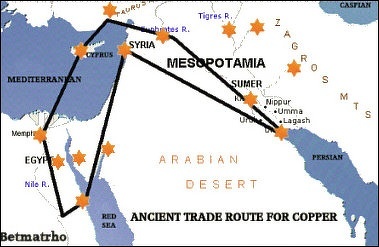
According to the University of Pennsylvania: “PG1237 included 6 men and 68 women. The men, near the tomb’s entrance, had weapons. Most of the women were in four rows across the northwest corner of the death pit; six under a canopy in its south corner; and, six near three lyres near the southeast wall. Almost all wore simple headdresses of gold, silver, and lapis; most had shells with cosmetic pigments. Body 61 in the west corner was more elaborately attired than the others. Half the women (but none of the men) had cups or jars, suggestive of banqueting. Body 61 held a silver tumbler close to her mouth. The neat arrangement of bodies convinced Woolley the attendants in the tombs had not been killed, but had gone willingly to their deaths, drinking some deadly or soporific drug. He suggested that in so doing they were assured a “less nebulous and miserable existence” than ordinary men and women.
“A study conducted by the University of Pennsylvania Museum of Archaeology and Anthropology on the skulls of a woman and a soldier, however, found signs of pre-mortem fractures caused by a blunt instrument. One of the theories emerging from this finding is that the dosage of poison consumed by some of the attendants was not enough to kill them, and therefore they were struck on their heads to prevent them from being buried alive.
See Separate Article: SUMERIAN RELIGION: CITY-STATE GODS, TEMPLES africame.factsanddetails.com
Ur Trade
Ur around 2000 B.C. was the center of a wealthy empire that drew traders from as far away as the Mediterranean Sea, 750 miles to the west, and the Indus civilization—called Meluhha by ancient Iraqis—some 1,500 miles to the east. [Source: Andrew Lawler, National Geographic, March 11, 2016 -]
Andrew Lawler wrote in National Geographic: “The bleak and tawny desert of southern Iraq is a strange place to find dark tropical wood. Even stranger, this sliver of ebony—no longer than a little finger—came from distant India 4,000 years ago. Archaeologists recently found the small artifact deep in a trench among the ruins of what was the world’s first great cosmopolitan city, providing a rare glimpse into an era that marked the start of the global economy. -
“There are texts that speak about the ‘black wood of Meluhha,’” said Elizabeth Stone of the State University of New York at Stony Brook, who is co-leading the Ur excavations. “But this is our first physical evidence.”
Along with the ebony and the clay tablets, the team uncovered a small clay mask of Humbaba, a giant who protects the cedars of distant Lebanon. The excavators also found dried dates in the grave of a child, the first plant remains found at the site. Other botanical finds are now being analyzed to understand how the diet of citizens changed over time.
Decline of Ur, the Amorites and Gutians

Poussin's vision of Joseph and the Amorites
Of the kings after Shar-kali-sharri (c. 2217-c. 2193 B.C.), only the names and a few brief inscriptions have survived. Quarrels arose over the succession, and the dynasty went under, although modern scholars know as little about the individual stages of this decline as about the rise of Akkad. [Source: piney.com]
The revival of Sumerian power under the Third Dynasty of Ur was short-lived. Ur was conquered by the Elamites, who captured its last king around 2004 B.C. Two factors contributed to its downfall: the invasion of the nomadic Amurrus (Amorites), called Martu by the Sumerians, from the northwest, and the infiltration of the Gutians, who came, apparently, from the region between the Tigris and the Zagros Mountains to the east. This argument, however, may be a vicious circle, as these invasions were provoked and facilitated by the very weakness of Akkad. In Ur III the Amorites, in part already sedentary, formed one ethnic component along with Sumerians and Akkadians. The Gutians, on the other hand, played only a temporary role, even if the memory of a Gutian dynasty persisted until the end of the 17th century B.C.. As a matter of fact, the wholly negative opinion that even some modern historians have of the Gutians is based solely on a few stereotyped statements by the Sumerians and Akkadians, especially on the victory inscription of Utu-hegal of Uruk (c. 2116-c. 2110). While Old Babylonian sources give the region between the Tigris and the Zagros Mountains as the home of the Gutians, these people probably also lived on the middle Euphrates during the 3rd millennium.
According to the Sumerian king list, the Gutians held the "kingship" in southern Mesopotamia for about 100 years. It has long been recognized that there is no question of a whole century of undivided Gutian rule and that some 50 years of this rule coincided with the final half century of Akkad. From this period there has also been preserved a record of a "Gutian interpreter." As it is altogether doubtful whether the Gutians had made any city of southern Mesopotamia their "capital" instead of controlling Babylonia more or less informally from outside, scholars cautiously refer to "viceroys" of this people. The Gutians have left no material records, and the original inscriptions about them are so scanty that no binding statements about them are possible.
End of Ur
Ancient texts suggest that Ur collapsed amid foreign invasions and internal dissension and, possibly, severe drought. Elizabeth Stone of the State University of New York at Stony Brook, who is currently, co-leading Ur excavations, is surprised by the lack of evidence for catastrophic destruction following 2000 B.C. “People seem to keep rebuilding their houses,” she told National Geographic. [Source: Andrew Lawler, National Geographic, March 11, 2016]
Morris Jastrow said: “For some time after Ur-Engur had established a powerful dynasty at Ur, the Sumerians seem to have had everything their own way. His son and successor, Dungi, wages successful wars, like Sargon and Naram-Sin, with the nations around and again assumes the larger title of “King of the Four Regions.” He hands over his large realm, comprising Elam on the one side, and extending to Syria on the other, to his son Bur-Sin. We know but few details of the reign of Bur-Sin and of the two other members of the Ur dynasty that followed him, but the indications are that the Sumerian reaction, represented by the advent of the Ur dynasty, though at first apparently complete, is in reality a compromise. [Source: Morris Jastrow, Lectures more than ten years after publishing his book “Aspects of Religious Belief and Practice in Babylonia and Assyria” 1911]
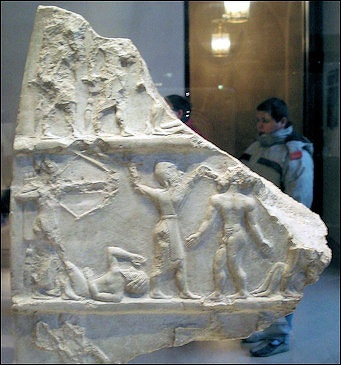
Akkadian victory stele
Semitic influence waxes stronger from generation to generation, as is shown by the steadily growing preponderance of Semitic words and expressions in Sumerian documents. The Semitic culture of Akkad not only colours that of Sumer, but permeates it so thoroughly as largely to eradicate the still remaining original and unassimilated Sumerian elements. The Sumerian deities as well as the Sumerians themselves adopt the Semitic form of dress. We even find Sumerians bearing Semitic names; and in another century Semitic speech, which we may henceforth designate as Babylonian, became predominant.
“On the overthrow of the Ur dynasty the political centre shifts from Ur to Isin. The last king of the Ur dynasty is made a prisoner by the Elamites, who thus again asserted their independence. The title “King of the Four Regions” is discarded by the rulers of Isin, and although they continue to use the title “King of Sumer and Akkad,” there are many indications that the supremacy of the Sumerians is steadily on the wane. They were unable to prevent the rise of an independent state with its centre in the city of Babylon under Semitic control, and about the year 2000 B.C., the rulers of that city begin to assume the title “King of Babylon.” The establishment of this so-called first dynasty of Babylon definitely foreshadows the end of Sumerian supremacy in the Euphrates Valley, and the permanent triumph of the Semites. Fifty years afterward we reach another main epoch, in many respects the most important, with the accession of Hammurabi to the throne of Babylon as the sixth member of the dynasty. During his long reign of forty-two years (ca. 1958-1916 B.C.), Hammurabi fairly revolutionised both the political and the religious conditions.”
Lament for the Destruction of Ur
Ur's destruction was commemorated in the “Lament for Ur.” Similar Mesopotamian works have been discovered, and scholars liken the “Lament for Ur” to the Book of Lamentations in the Bible. Also known as The Lament for Ur, or Lamentation over the Destruction of Ur, it is a Sumerian lament composed around the time of the fall of Ur to the Elamites and the end of the city's third dynasty (c. 2000 BC). In it the goddess of Ur seems to be the mourning or lament leader and, on command, the people mourn. ("the goddess of Ur, Ningal, tells how she suffered under her sense of coming doom.") [Source: piney.com, Wikipedia]
When I was grieving for that day of storm,
that day of storm, destined for me, laid upon me, heavy with tears,
that day of storm, destined for me, laid upon me heavy with tears, on me, the queen.
Though I was trembling for that day of storm,
that day of storm destined for me —
I could not flee before that day's fatality.
And of a sudden I espied no happy days within my reign, no happy days within my reign. [Source: Thorkild Jacobsen, “The Treasures of Darkness: A History of Mesopotamian Religion”]
Though I would tremble for that night,
that night of cruel weeping destined for me,
I could not flee before that night's fatality.
Dread of the storm's floodlike destruction weighed on me,
and of a sudden on my couch at night, upon my couch at night no dreams were granted me.
And of a sudden on my couch oblivion, upon my couch oblivion was not granted.
Because (this) bitter anguish had been destined for my land —
as the cow to the (mired) calf — even had I come to help it on the ground,
I could not have pulled my people back out of the mire.
Because (this) bitter dolor had been destined for my city,
even if I, birdlike, had stretched my wings,
and, (like a bird), flown to my city,
yet my city would have been destroyed on its foundation,
yet Ur would have perished where it lay.
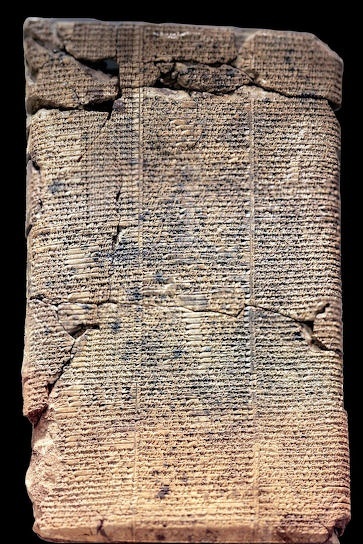
Because that day of storm had raised its hand,
and even had I screamed out loud and cried; "Turn back, O day of storm, (turn) to (thy) desert,"
the breast of that storm would not have been lifted from me.
Then verily, to the assembly, where the crowd had not yet risen,
while the Anunnaki, binding themselves (to uphold the decision), were still seated,
I dragged my feet and I stretched out my arms,
truly I shed my tears in front of An.
Truly I myself mourned in front of Enlil:
"May my city not be destroyed!" I said indeed to them.
"May Ur not be destroyed!" I said indeed to them.
"And may its people not be killed!" I said indeed to them.
But An never bent towards those words,
and Enlil never with an, "It is pleasing, so be it!" did soothe my heart.
(Behold,) they gave instruction that the city be destroyed,
(behold,) they gave instruction that Ur be destroyed,
and as its destiny decreed that its inhabitants be killed.
Enlil (wind god or spirit) called the storm. The people mourn.
Winds of abundance he took from the land. The people mourn.
Good winds he took away from Sumer. the people mourn.
Deputed evil winds. The people mourn.
Entrusted them to Kingaluda, tender of storms.
He called the storm that annihilates the land. The people mourn.
He called disastrous winds. The people mourn.
Enlil — choosing Gibil as his helper —
called the (great) hurricane of heaven. The people mourn.
The (blinding) hurricane howling across the skies — the people mourn —
the tempest unsubduable like breaks through levees,
beats down upon, devours the city's ships,
(all these) he gathered at the base of heaven. The people mourn.
(Great) fires he lit that heralded the storm. The people mourn.
And lit on either flank of furious winds the searing heat of the desert.
Like flaming heat of noon this fire scorched.
The storm ordered by Enlil in hate, the storm which wears away the country,
covered Ur like a cloth, veiled it like a linen sheet.
On that day did the storm leave the city; that city was a ruin.
O father Nanna, that town was left a ruin. The people mourn.
On that day did the storm leave the country. The people mourn.
Its people('s corpses), not potsherds,
littered the approaches.
The walls were gaping;
the high gates, the roads,
were piled with dead.
In the wide streets, where feasting crowds (once) gathered, jumbled they lay.
In all the streets and roadways bodies lay.
In open fields that used to fill with dancers,
the people lay in heaps.
The country's blood now filled its holes, like metal in a mold;
bodies dissolved — like butter left in the sun.
(Nannar, god of the Moon and spouse of Ningal, appeals to his father, Enlil)
O my father who engendered me! What has my city done to you? Why have you turned away from it?
O Enlil! What has my city done to you? Why have you turned away from it?
The ship of first fruits no longer brings first fruits to the engendering father,
no longer goes in to Enlil in Nippur with your bread and food portions!
O my father who engendered me! Fold again into your arms my city from its loneliness!
O Enlil! Fold again my Ur into your arms from its loneliness!
Fold again my (temple) Ekishnugal into your arms from its loneliness!
Let renown emerge for you in Ur! Let the people expand for you:
let the ways of Sumer, which have been destroyed,
be restored for you!
Enlil answered his son Suen (saying):
"The heart of the wasted city is weeping, reeds (for flutes) of lament grow therein,
its heart is weeping, reeds (for flutes) of lament grow therein,
its people spend the day in weeping.
O noble Nanna, be thou (concerned) about yourself, what truck have you with tears?
There is no revoking a verdict, a decree of the assembly,
a command of An and Enlil is not known ever to have been changed.
Ur was verily granted a kingship — a lasting term it was not granted.
From days of yore when the country was first settled, to where it has now proceeded,
Who ever saw a term of office completed?
Its kingship, its term of office, has been uprooted. It must worry.
(You) my Nanna, do you not worry! Leave your city!"
Ur Archaeology
Andrew Lawler wrote in National Geographic: “In the 1920s and 1930s, British archaeologist Leonard Woolley dug up some 35,000 artifacts from Ur, including the spectacular remains of a royal cemetery that included more than 2,000 burials and a stunning array of gold helmets, crowns, and jewelry that date to about 2600 B.C. At the time, the discovery rivaled that of King Tut’s tomb in Egypt. The excavation was sponsored jointly by the British Museum and the University of Pennsylvania Museum, and the finds were divided between London, Philadelphia and Baghdad, following the tradition of the era. [Source: Andrew Lawler, National Geographic, March 11, 2016 -]
“But Ur and most of southern Iraq has been off limits to most archaeologists during the past half-century of war, invasion, and civil strife. A joint U.S.-Iraqi team reopened excavations there last fall, digging at the site for ten weeks. The work was supported in part by the National Geographic Society. Unlike earlier generations, today’s archaeologists are less interested in breathtaking gold objects than in clues like the bit of ebony that will help them understand more fully this critical time in human history.” -
“Most digs in the past, including Woolley’s, focused on the temples, tombs, and palaces. But during the recent excavation, the team uncovered a modest-sized building dating to a couple of centuries after Ur’s peak. “This is a typical Iraqi house,” said Abdul-Amir Hamdani, the senior Iraqi archaeologist on the project, who grew up in the area. He gestures at the mud-brick walls. “There are stairs to the roof and rooms around a courtyard. I lived in a house just like this. There’s a continuity in the way people live here.” -
“That hints, Stone and Hamdani said, at a society that wasn’t under the control of a small tyrannical minority. By bringing such analysis to bear on common objects like grains, bones, and less flashy artifacts, the team hopes to shed light on how workers lived, the role of women in the wool factories, and how environmental changes might have impacted the eventual decline of Ur’s power.” -
Image Sources: Wikimedia Commons
Text Sources: Internet Ancient History Sourcebook: Mesopotamia sourcebooks.fordham.edu , National Geographic, Smithsonian magazine, especially Merle Severy, National Geographic, May 1991 and Marion Steinmann, Smithsonian, December 1988, New York Times, Washington Post, Los Angeles Times, Discover magazine, Times of London, Natural History magazine, Archaeology magazine, The New Yorker, BBC, Encyclopædia Britannica, Metropolitan Museum of Art, Time, Newsweek, Wikipedia, Reuters, Associated Press, The Guardian, AFP, Lonely Planet Guides, “World Religions” edited by Geoffrey Parrinder (Facts on File Publications, New York); “History of Warfare” by John Keegan (Vintage Books); “History of Art” by H.W. Janson Prentice Hall, Englewood Cliffs, N.J.), Compton’s Encyclopedia and various books and other publications.
Last updated June 2024

